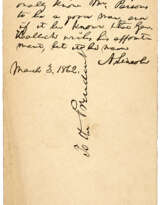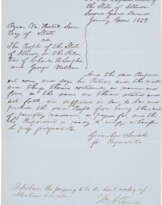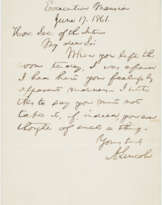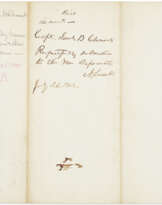ID 1119247
Lot 149 | The earliest obtainable copy of the final Emancipation Proclamation
Valeur estimée
$ 20 000 – 30 000
Abraham Lincoln, 3 January 1863
LINCOLN, Abraham (1809-1865). EMANCIPATION PROCLAMATION. By the President of the United States of America. A Proclamation. Whereas...[46 lines of text]… By the President. [Washington, D.C.: Government Printing Office, c. 3 January 1863].
The official and first obtainable broadside printing of Lincoln's final Emancipation Proclamation. Lincoln confided to a friend that he saw the Emancipation Proclamation as "the central act of my administration, and the great event of the nineteenth century." As historian John Hope Franklin has written, Lincoln's Proclamation "has maintained its place as one of America's truly important documents," even though "it had neither the felicity of the Declaration of Independence nor the simple grandeur of the Gettysburg Address." But it undoubtedly constituted a critical "step toward the extension of the ideal of equality about which Jefferson had written." And in time, Franklin adds, "the greatness of the document dawned upon the nation and the world. Gradually, it took its place with the great documents of human freedom" (The Emancipation Proclamation, 1963, pp.143-144). The influence it commanded, from the very moment of its issuance is amply demonstrated by the multiple printed forms in which it was issued, in many localities, over the next year (this array of printed, engraved, and lithographic versions is the subject of Charles Eberstadt's bibliography).
While it did not and could not end slavery throughout the divided nation, the Emancipation Proclamation constituted a fundamental act of justice with potent moral and humanitarian significance. Frederick Douglass wrote that he "saw in its spirit a life and power far beyond its letter." By Lincoln's Proclamation, the road to freedom was thrown open to millions who had been held as chattel slaves. It paved the way for the soon-to-be-adopted Thirteenth Amendment, which finally eliminated slavery within the United States, a major step towards the fulfillment of the promise of Jefferson's ringing pronouncement in the Declaration of Independence: "all men are created equal." Truly, it gave the nation what Lincoln himself, in the Gettysburg Address would rightly term, a few months later, "a new birth of freedom."
This broadside—embodying that momentous text—was issued immediately after the proclamation became law on 1 January 1863, and is preceded only by a newspaper "extra" and an interim small-format printing, both of which survive in only one copy (see below). The present broadside is preceded by seven printings of the preliminary proclamation as announced on 22 September 1862. The text of the final, official proclamation was the result of discussion with the cabinet on the morning of 31 December. After many suggestions were offered and discussed, Lincoln retired to compose the final proclamation, completed later that day. The final text was rushed to the government printer and this official State Department printing of the final proclamation is thus preceded only by the following:
1. Eberstadt 8. A small-format issue, "printed in haste to serve the urgent need for a few copies until the resplendent, official folio edition [this one] could be prepared" (Eberstadt, p. 17). Known in only a single copy.
2. Eberstadt 9: A broadside "extra" issued by the Illinois State Journal, Springfield, 2 January 1863. Known in only one copy, at the Lincoln Presidential Library in Springfield.
Rare. Only nine other copies are known extant, four of which are part of institutional collections including Brown, Clements Library, The Huntington Library and the Library of Congress. Eberstadt, Lincoln's Emancipation Proclamation, no. 10.
One page, bifolium 332 x 211mm (extremely minor spots of soiling at extreme margins, miniscule chip to top margin of the second [and blank] leaf).
| Artiste: | Abraham Lincoln (1809 - 1865) |
|---|---|
| Catégorie maison de vente aux enchères: | Lettres, documents et manuscrits |
| Artiste: | Abraham Lincoln (1809 - 1865) |
|---|---|
| Catégorie maison de vente aux enchères: | Lettres, documents et manuscrits |
| Adresse de l'enchère |
CHRISTIE'S 20 Rockefeller Plaza 10020 New York Etats-Unis | ||||||||||||||
|---|---|---|---|---|---|---|---|---|---|---|---|---|---|---|---|
| Aperçu |
| ||||||||||||||
| Téléphone | +1 212 636 2000 | ||||||||||||||
| Fax | +1 212 636 4930 | ||||||||||||||
| Conditions d'utilisation | Conditions d'utilisation | ||||||||||||||
| transport |
Service postal Service de messagerie ramassage par vous-même | ||||||||||||||
| Modes de paiement |
Virement bancaire | ||||||||||||||
| Heures d'ouverture | Heures d'ouverture
|











